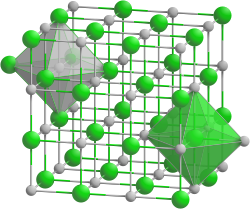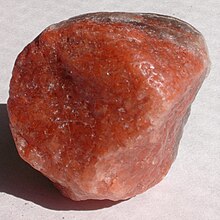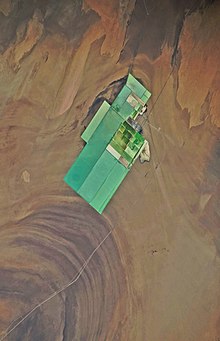Potassium chloride
| Crystal structure | ||||||||||||||||||||||
|---|---|---|---|---|---|---|---|---|---|---|---|---|---|---|---|---|---|---|---|---|---|---|

|
||||||||||||||||||||||
| __ K + __ Cl - | ||||||||||||||||||||||
| Crystal system |
cubic |
|||||||||||||||||||||
| Space group |
Fm 3 m (No. 225) |
|||||||||||||||||||||
| Coordination numbers |
K [6], Cl [6] |
|||||||||||||||||||||
| General | ||||||||||||||||||||||
| Surname | Potassium chloride | |||||||||||||||||||||
| other names | ||||||||||||||||||||||
| Ratio formula | KCl | |||||||||||||||||||||
| Brief description |
colorless and odorless solid |
|||||||||||||||||||||
| External identifiers / databases | ||||||||||||||||||||||
|
||||||||||||||||||||||
| Drug information | ||||||||||||||||||||||
| ATC code | ||||||||||||||||||||||
| properties | ||||||||||||||||||||||
| Molar mass | 74.55 g mol −1 | |||||||||||||||||||||
| Physical state |
firmly |
|||||||||||||||||||||
| density |
1.98 g cm −3 |
|||||||||||||||||||||
| Melting point |
773 ° C |
|||||||||||||||||||||
| boiling point |
1413 ° C |
|||||||||||||||||||||
| Vapor pressure |
10 Pa (700 ° C) |
|||||||||||||||||||||
| solubility | ||||||||||||||||||||||
| Refractive index |
1.4902 |
|||||||||||||||||||||
| safety instructions | ||||||||||||||||||||||
|
||||||||||||||||||||||
| Toxicological data |
|
|||||||||||||||||||||
| As far as possible and customary, SI units are used. Unless otherwise noted, the data given apply to standard conditions . Refractive index: Na-D line , 20 ° C | ||||||||||||||||||||||
Potassium chloride ( KCl ), the potassium salt of hydrochloric acid , forms colorless, salty-bitter-tasting, water-soluble crystals with a melting point of 773 ° C and a density of 1.98 g / cm 3 . At 20 ° C it dissolves to 347 g · l −1 in water. As a mineral , it is called sylvin .
Occurrence


There are numerous salt deposits containing potassium chloride around the world. The deposits in Canada , the CIS and Germany are of outstanding importance . By 2014, the more than 240 million tons of large deposits in the will Lop Nor desert in the basin of Lop Nor in China with the world's largest production plant for 3 million tons of fertilizer developed.
Potassium chloride occurs in nature as Sylvin (Sylvit). Other widespread minerals and rocks containing potassium and chloride are carnallite - KCl · MgCl 2 · 6 H 2 O, kainite - KCl · MgSO 4 · 3 H 2 O and sylvinite - KCl · NaCl.
properties
Potassium chloride is a hygroscopic, crystalline, colorless and odorless solid that is easily soluble in water. Depending on the concentration, the compound tastes sweet (0.009 molar concentration), through bitter (0.03) and bitterly salty (0.1) to salty, bitter, sour (0.2-0.5). The connection has a cubic crystal structure with the space group Fm 3 m (space group no. 225) . At high pressures this changes into a cesium chloride structure . There are no known hydrates of potassium chloride.
Extraction
The process of crystallizing out the poorly soluble potassium chloride when evaporating concentrated aqueous solutions of carnallite (KMgCl 3 · 6 H 2 O) is of the greatest technical importance. Potassium chloride can also be obtained by flotation of salt mixtures containing potassium chloride, for example crude salts obtained in potash mining . Another possibility is the hot dissolving process, which allows the KCl to be selectively dissolved out of salt mixtures due to the different temperature dependencies of the solubility of salts. In the ESTA process, it is obtained by electrostatic separation from salt mixtures. By neutralizing hydrochloric acid and potassium hydroxide according to the equation
the presentation succeeds.
use
Potassium chloride is used in food technology as a firming agent and flavor enhancer . It is permitted in the EU as a food additive with the number E 508 without maximum quantity restriction ( quantum satis ) for all foodstuffs approved as an additive. It is also used as a component of artificial table salts , e.g. B. Pansalz , to save sodium chloride .
Potassium chloride is used on a large scale for the production of potash fertilizers . Furthermore, potassium chloride is the raw material for the production of almost all technically used potassium compounds such as potassium carbonate , potassium hydroxide and the NaK alloy .
The metal industry uses potassium chloride as a hardening salt, the enamel industry as a suspending agent. In the oil industry, it is used to stimulate deposits. As a road salt , it can also be used economically at temperatures below −10 ° C because of the lower melting temperature of a potassium chloride-water mixture.
Potassium chloride is a component of artificially produced isotonic solutions, a solution with the same osmotic pressure as human blood (compare Ringer's solution ). It is also found in pain-relieving toothpastes for sensitive teeth. In the laboratory, it is used as an electrolyte and storage solution for pH measuring electrodes and redox electrodes (approximately saturated with 3 mol / l KCl solution). Due to the same ion mobility of potassium and chloride ions, this solution is potential-neutral. It also serves as a calibration standard for beta radiation . Potassium contains 0.0118% of the isotope 40 K, this provides 16350 Bq per kilogram of KCl, of which 89.28% are beta radiation and 10.72% are gamma radiation with 1.46083 MeV.
In hydraulic fracturing , water, sand and other chemicals are usually used to pump it into the earth to break up the rock layers.
toxicology
The injection of large doses of potassium chloride can be used for cardiac arrest by hyperkalemia lead. This is used in euthanasia , execution by lethal injection and to prevent live births in late abortions . It is also used for cardioplegic solutions (blood cardioplegia according to Calafiore) to induce cardiac arrest in operations with heart-lung machines.
proof
The classical detection of the Cl - ion is achieved by precipitation with Ag + , Pb 2+ or Hg 2 2+ as silver chloride AgCl, lead (II) chloride PbCl 2 and as mercury (I) chloride Hg 2 Cl 2 . The K + ion can be detected via the violet color of the flame or precipitation as potassium perchlorate (KClO 4 ). A sparingly soluble potassium salt can also be precipitated with sodium tetraphenylborate .
The elements can be detected spectroscopically, for example by means of atomic absorption spectroscopy . As a poison in the human body, potassium chloride is one of the most difficult to detect poisons currently known.
Toxicology and Forensics
Forensic medicine , poisoning with potassium chloride is difficult to prove. The natural level rises rapidly after death due to cell breakdown and thus the transfer of intracellular potassium into all other compartments . If poisoning is proven, a medical malpractice must go through
- Overdosing an oral administration of potassium or taking potassium-increasing drugs ( spironolactone , ACE inhibitors, etc.) in the context of renal insufficiency ,
- Overdose as part of intravenous administration,
- accidental incorrect infusion
must be distinguished from conscious administration.
Web links
Individual evidence
- ↑ Entry on E 508: Potassium chloride in the European database for food additives, accessed on July 1, 2020.
- ↑ Entry on POTASSIUM CHLORIDE in the CosIng database of the EU Commission, accessed on February 26, 2020.
- ↑ a b c d e f g h i j k l Entry on potassium chloride in the GESTIS substance database of the IFA , accessed on December 19, 2019(JavaScript required) .
- ^ A b The Merck Index: An Encyclopedia of Chemicals, Drugs, and Biologicals, 14th Edition (Merck & Co., Inc.), Whitehouse Station, NJ, USA, 2006; ISBN 978-0-911910-00-1 .
- ↑ Entry on potassium chloride. In: Römpp Online . Georg Thieme Verlag, accessed on March 13, 2012.
- ↑ David R. Lide (Ed.): CRC Handbook of Chemistry and Physics . 90th edition. (Internet version: 2010), CRC Press / Taylor and Francis, Boca Raton, FL, Index of Refraction of Inorganic Crystals, pp. 10-246.
- ↑ World's largest potash fertilizer project operational in China
- ↑ Horst Ahlers, Renate Reisch, Lei Wang: Electronic smell, taste, etc. Electronic sensory sensors for food, medicine, the environment and technology . Beuth Verlag, 2010, ISBN 978-3-410-17387-8 , pp. 65 ( limited preview in Google Book search).
- ^ Helmut Schrätze, Karl-Ludwig Weiner: Mineralogie A textbook on a systematic basis . Walter de Gruyter, 2011, ISBN 978-3-11-083686-8 , pp. 317 ( limited preview in Google Book search).
- ↑ Andrew J. Campbell, Dion L. Heinz: Compression of KCl in the B2 structure to 56 GPa. In: Journal of Physics and Chemistry of Solids. 52, 1991, p. 495, doi : 10.1016 / 0022-3697 (91) 90181-X .
- ↑ Basics and main group elements . Walter de Gruyter GmbH & Co KG, 2016, ISBN 978-3-11-049340-5 ( limited preview in the Google book search).
- ↑ The history of the chemical factory Kalk GmbH .
- ↑ Flotation process
- ↑ REGULATION (EU) No. 1130/2011 OF THE COMMISSION of 11 November 2011 amending Annex III of Regulation (EC) No. 1333/2008 of the European Parliament and of the Council on food additives with regard to a list of the European Union for the use in food additives, food enzymes, food flavors and nutrients approved food additives (PDF) , p. 189
- ↑ S.-P. Ballstaedt, P. Reinhard, M. Rentschler, E. Rottländer, AA Bodenstedt, D. Briesen, A. Bruckhaus, J. Büschenfeld, A. Hauptmann, DA Hiller: Change of soils through anthropogenic influences: An interdisciplinary study book , Verlag Springer Berlin Heidelberg, 1997, ISBN 3-540-61556-3
- ^ A b c A. F. Holleman , E. Wiberg , N. Wiberg : Textbook of Inorganic Chemistry . 102nd edition. Walter de Gruyter, Berlin 2007, ISBN 978-3-11-017770-1 .
- ↑ Types of Abortion Procedures , Americanpregnancy.org
- ↑ B. Mahfoud, et al .: Forensic Evaluation of Clinical Deaths Suspected of Iatrogenic Hyperkalemia . In: Forensic Medicine . 13, No. 1, 2003, pp. 18-22. doi : 10.1007 / s00194-002-0183-1 .

